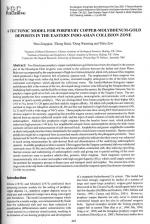Добрый день, Коллеги. Важное сообщение, просьба принять участие. Музей Ферсмана ищет помощь для реставрационных работ в помещении. Подробности по ссылке
A Tectonic Model for Porphyry Copper-Molybdenum-Gold Deposits in the Eastern Indo-Asian Collision Zone
Two Himalayan porphyry copper-molybdenum-gold belts have been developed in the eastern part of the Himalayan-Tibet orogenic zone related to the collision between the Indian and Asian Plates. Both were accompanied by the emplacement of high-level intracontinental, alkali-rich, potassic felsic magmas which produced a huge Cenozoic belt of potassic igneous rock. The emplacement of these magmas was controlled by large-scale strike-slip fault systems, orientated roughly orthogonal to the of the Indo-Asian continental convergence, which adjusted the collisional strain. The Jomda-Markam-Xiangyun copper-molybdenum belt is the western of the two, developed along a narrow zone following the Nanqian thrust, the Jinshajiang fault system, and the Red River shear zone, whereas the eastern, the Zhongdian-Yanyuan-Yao'an porphyry copper-gold-silver belt, was developed along the western margin of the Yangtze Craton. The ore-bearing porphyries have compositions which include granite, monzogranite, and monzonite, with a small amount of quartz-syenite porphyry. They are distinguished from barren porphyries by their higher Si02 (>63 wt %), lower Y (<20 ppm) and their adakitic magma affinity. All alkali-rich porphyries are relatively enriched in large-ion lithophile elements (K, Rb and Ba) and depleted in high-field strength elements (Nb, Ta, Ti and P) with a wide range of Nb/Y ratios.
These porphyries also show strong REE fractionation but no obvious negative Eu anomaly, suggesting that possible magma sources underwent metasomatism by fluids derived from an ancient subducted oceanic slab, and the input of small-volumes of melts derived from the asthenosphere. Adakite-like porphyries might originate from the basaltic lower crust, which probably underwent high-pressure (>40 km), low amphibolite-eclogite facies metamorphism during the Indo-Asian continent collision and metasomatism of slab-derived fluids. Amphibolite and garnet- amphibolite xenoliths in alkali-rich porphyries have been interpreted to be samples of such lower-crustal materials. Barren syenite porphyries might have originated from an enriched mantle characterised by the phlogopite peridotite. Trace element and Sr-Nd-Pb isotope systematics of these barren porphyries indicate that their source was subjected to much strong metasomatism by slab-derived fluid and dissemination of the underlying asthenospheric material. Available geophysical data in eastern Tibet suggest that the Yangtze continental slab was subducted westwards since 50 Ma and collided with the subducted Indian continental slab, thus inducing upwelling, thermal erosion and underplating of asthenospheric melts and giving rise to partial melting of the crust-mantle transition zone to produce adakite-like, potassic, felsic magmas. Such magmatic systems are characteristically rich in water and sulphur with high oxygen fugacity (/O2), which could largely result in the potential for magmatic process to better carry and transport metal and sulphur. The intersection of the large-scale strike-slip faults with basement lineaments controlled the temporal-spatial localisation of porphyry Cu-Mo-Au systems.




